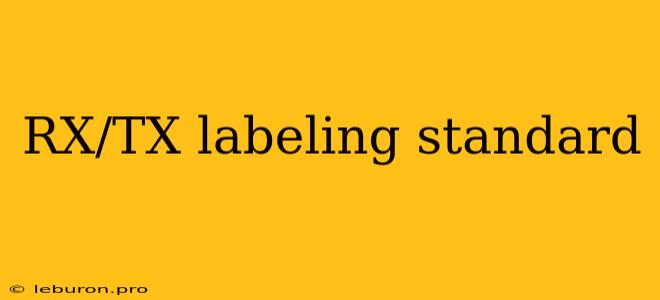The realm of electronics is marked by a complex interplay of signals and data transmission. Ensuring the smooth flow of information requires clear and consistent labeling conventions, especially when it comes to the direction of signal flow. This is where the RX/TX labeling standard comes into play, providing a universal language for identifying the receiver and transmitter components in electronic devices. This article delves into the significance of the RX/TX labeling standard, its historical background, applications, and variations across different devices.
The Essence of RX/TX Labeling
At its core, the RX/TX labeling standard is a simple yet crucial convention used to differentiate between the receiving and transmitting elements in electronic communication systems. The abbreviations "RX" and "TX" stand for "receive" and "transmit," respectively. This labeling is vital for ensuring accurate signal routing and understanding the direction of data flow within a circuit.
Historical Context
The roots of the RX/TX labeling standard can be traced back to the early days of radio communication. As technology evolved, this labeling system became widely adopted in various communication technologies, including:
- Radio and Television: In these systems, the RX and TX designations are used to distinguish between the receiver and transmitter units.
- Data Communication: With the advent of computer networks, the RX/TX labeling standard found its way into network interfaces, particularly in Ethernet and serial ports.
- Wireless Communication: Modern wireless technologies like Bluetooth, Wi-Fi, and cellular networks also rely on the RX/TX labeling standard to differentiate between incoming and outgoing signals.
Practical Applications of RX/TX Labeling
The RX/TX labeling standard has become an integral part of various electronic devices and systems:
- Network Interfaces: Network cards, routers, and switches use RX/TX labeling to indicate the direction of data flow on their ports. For example, a network interface card will have an RX port to receive data from the network and a TX port to send data to the network.
- Serial Ports: Serial ports commonly use RX/TX labeling to identify the receive and transmit lines. This is crucial for sending and receiving data over serial connections.
- Remote Control Devices: Remote controls often use RX/TX labeling to indicate the direction of signals. The remote control transmits signals (TX), and the device receives them (RX).
- Audio Equipment: Audio devices, such as amplifiers and microphones, often employ RX/TX labeling for input and output channels.
- Computer Peripherals: Peripherals like printers, scanners, and external hard drives utilize RX/TX labeling to ensure proper communication with the computer.
Variations in RX/TX Labeling
While the RX/TX labeling standard is widely recognized, slight variations may exist depending on the specific application. These variations typically involve the addition of other letters or symbols to provide more detailed information. For instance:
- TX/RX-D: The "D" indicates a differential signal, where two wires are used to transmit data in both directions simultaneously.
- TX+ and TX-: These labels represent positive and negative signals within a differential pair for transmission.
- RX+ and RX-: Similarly, these labels represent positive and negative signals within a differential pair for reception.
- TXEN: "TXEN" stands for "transmit enable" and indicates a signal used to control the transmission of data.
- RTS/CTS: These are Request to Send and Clear to Send signals used to control the flow of data in serial communication.
The Significance of Consistent Labeling
The consistent use of the RX/TX labeling standard across different devices and applications is crucial for several reasons:
- Simplified Troubleshooting: Clear labeling simplifies the process of identifying and resolving communication issues. It allows technicians to quickly pinpoint the source of problems related to signal flow.
- Enhanced Compatibility: The standard ensures compatibility between different devices and systems. It eliminates the need for complex mapping between different labeling conventions.
- Reduced Errors: Consistent labeling reduces the chances of misconnecting wires or misinterpreting data flow, thus preventing system errors.
Conclusion
The RX/TX labeling standard is an essential element in the world of electronics, providing a universal language for signal flow. Its simplicity and widespread adoption make it a vital tool for engineers, technicians, and hobbyists alike. By understanding the RX/TX labeling standard, one gains a deeper appreciation for the intricate interplay of signals that power our modern electronic devices and systems. This standard ensures clear communication, simplifies troubleshooting, and promotes compatibility between devices, contributing to a more efficient and reliable electronic landscape.
